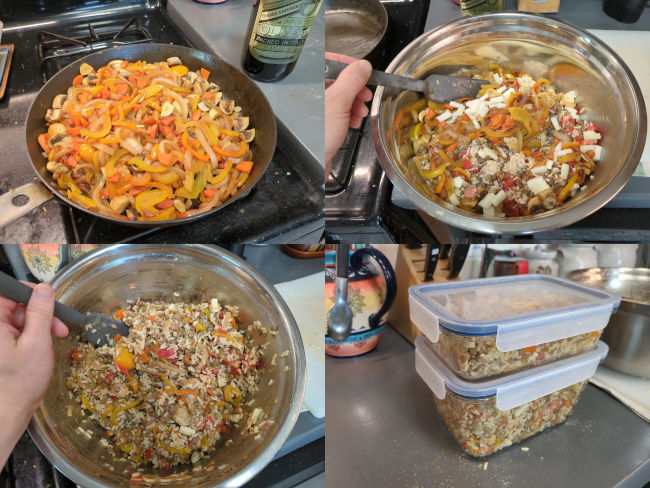The Virtues of Groceries
groceries frugality eating food
Warnings:
- This topic, personal eating habits, is tired. Anything I could say, a different nerd has said better.
- I currently eat meat but try to avoid eating mammals, which I learned today is called mafism.
- I’m a mid-30s knowledge worker who lives with a partner. We share some meals spontaneously but don’t plan around it, each keeping our own separate food. My experience won’t generalize if your situation is very different.
Returning from a long and tasty vacation, my partner and I made an unusually serious commitment to each other: no restaurant, cafe, or take-out food for a whole month. We allowed one narrow exception, non-caloric beverages (e.g. black tea or coffee) in a social setting. That aside, everything we ate had to come from home (and ultimately from a grocery store). For this impatient millenial, getting everything I eat from a grocery store was a big change of routine.

My routine leading up to this:
- Before 2020
- Lost pre-history.
- 2020-2021
- Scary virus.
- Eat 95% at home, 5% take-out.
- Learn to make good pizza and yogurt from scratch (later forgot).
- 2021-2023
- Start working from cafes.
- Often spend $20-40 USD at whatever cafes I happened to visit that day.
- Often get take-out for dinner (or in a pinch, Taco Bell).
- Slowly forget how to make food at home.
- 2024 March to July
- Start a tiny co-working space.
- Start habit of bringing breakfast to the office from home, but frequently, lunch from a restaurant.
- 2024 second half of July
- Eat at restaurants across Europe 2-3 times per day.
Today, the last day of August, is the last day of our pact. I have stuck with it. Reflection follows.
Why did this?
It became salient that food from a restaurant or cafe is:
- several times more expensive than food from a grocery store!
- less healthy because we don’t control the ratio of macronutrients, or the sugar and salt going into it.
- often the wrong portion size: a tiny pastry at a cafe when you’re hangry, or (more often) a Really Big Bowl of noodles that you feel irrationally pressured to finish.
- often a super-stimulus, which I want to reduce exposure to.
- in take-out form, an outsized consumer of single-use plastic that probably doesn’t get recycled no matter which bin it ends up in.
- in some ways less convenient than groceries at home, because each meal requires travel and/or waiting.
(Neither of us were trying to lose weight, and mine probably didn’t change much over the month.)
What did I learn?
First, I must keep ahead with planning.
With Restaurant Brain™, I can go about my day completely forgetting that food exists. Then I get hungry, go to a place, and tasty food magically appears. (Repeat several hours later, tomorrow, etc.)
With Grocery Life™, I cannot do this, because (at least where I live) a grocery trip followed by cooking takes too long when I’m already hungry. A well-organized grocery trip takes longer still.
So, to win at grocery life requires thinking a week (or more) ahead. What will I want to eat? What do I know how to make?
The prep work takes time. I’ve spent 3+ hours each weekend buying groceries and pre-cooking a bunch of stuff for the coming week. I don’t try to “meal prep” in the sense of pre-portioning meals, but I will pre-:
- Grill a bunch of chicken thighs and some salmon
- Cook some brown rice, farro, and/or lentils
- Maybe make a batch of Nutrient Slop (recipe below)
- Maybe bake a loaf of, e.g., banana bread (from a box with instructions)
If I’ll spend much of a given day away from home, I also need to portion and pack whatever meals I’ll want to eat. This takes probably 15-20 minutes each weekday morning.
The reward that this system delivers, for all the work to run it? Tasty, healthy, appropriately-portioned, inexpensive meals, ready with minimal assembly and heating, whenever I get hungry. That sure beats take-out.
What else? I’ll get several kinds of fruit. Strawberries, cherries, bananas. I generally eat some at the end of both breakfast and lunch. It’s (usually) sweet enough to stop me from craving junk food.
What I eat in a typical day?
- Breakfast at the office
- Hot oatmeal with chicken sausage and chopped apple stirred in.
- A handful of strawberries on the side.
- Lunch at the office
- A pre-made burrito (chicken, corn, beans, rice), microwaved and then finished in the toaster oven.
- A handful of cherries on the side.
- Dinner at home
- A big bowl containing
- A hunk of fish or chicken (cooked the previous weekend).
- Brown rice.
- Half of a bag salad kit, with the dressing all over everything.
- A big bowl containing
- Dessert / evening snack
- Granola with oat milk and chopped strawberries.
Accidental Love Letter to Trader Joe’s
I believe that Trader Joe’s, more than other grocery stores, reduces the effort of eating tasty, sort-of-healthy food, for sort-of-cheap. (That said, you save a bunch of money if you buy your meat from a variant of the Kroger Empire, or Wal-Mart or Costco, I guess.)
Try the TJs bag salad kits that include dressing and some nuts or crunchy bits. They make it easy to add a lot of plants to a meal. Just watch for added sugar in the dressing. The salad kit alone typically has more dressing than I need, but if I’m eating it with salmon and rice, I welcome the extra dressing to season the rice.
Try the pre-made burritos, refrigerated section, under $5 each. Here is a nano-review of each variant.
- Pollo asado: +2 tasty, good salsa, fiber from beans.
- Vegetable samosa: +2 amazing but usually out of stock here. :(
- Beans and rice: 0 filling, cheesy, but boring texture.
- Carnitas with salsa verde: 0 somewhat tasty but I try to avoid pork.
- Chicken sausage breakfast: 0 tasty but needs salsa, cholesterol from eggs.
- Cheeseburger: -1 very tasty but not that great for you.
- Spinach & Feta Egg White: -1 not much flavor.
- Turkey & Sweet Potato: appears to exist online but NEVER seen in store.
- Jerk Chicken: ditto.
“Organic Rolled Oats with Ancient Grains and Seeds” forms the base of my breakfast on weekdays.
When I cook a bunch of meat, I’ll glop on some Soy Vay (or “Soyaki”, the TJ equivalent), let it soak for a few minutes, then grill it outside.
A good “ah crap we’re out of everything” dinner that keeps forever: a frozen bag of vegetable fried rice and a frozen bag of shrimp. (TJs has both.) Sautee the fried rice while the shrimp thaws in a bowl under running water, then stir the shrimp in.
Do I have food storage opinions?
These aren’t new opinions, but yes, the IKEA 365+ food containers are superior. They come in multiple materials and sizes. For the 34 oz and 61 oz sizes, all of the lids are cross-compatible. The latch-on lids are pretty leakproof and I’ve found the latches are durable.
Get a bunch of 34 oz and 61 oz glass containers for home. Get several 34 oz metal and plastic containers to take places. Also get a set of inserts to keep meal components separated in transit.
Just be aware that when you drop a glass one, it will shatter violently. I prefer to travel with the metal ones (or plastic if I’ll need to microwave it).
What about Soylent? Other meal replacement products?
From 2015 to 2017, I ate drank a lot of Soylent, mixed from powder, and it was great. There was a week when I consumed only Soylent and no other food; that was great too. Eventually, I mostly stopped because it started to hurt my stomach. I don’t know why.
I had a bottle of yfood from a vending machine in Germany and it was great. I see they sell powdered mix too, but unfortunately none of it is available in the USA.
I’ve eaten a lot of the previous version of MealSquares, and I’m waiting for my first box of version 2.0.
cmart’s Nutrient Slop recipe
All quantities are approximate. Make your slop different than mine!
- Pre-cook:
- Some brown rice (8 ounces or 225g).
- Some lentils (6 ounces or 170g).
- Chop up and saute together:
- 2 bell peppers.
- 2 onions.
- A bunch of mushrooms (maybe discard the stems).
- A carrot.
- Maybe some kale?
- A few cloves of garlic (or just throw it in raw later).
- Then, assemble and stir in a big mixing bowl:
- The cooked rice and lentils.
- Everything you just sauteed.
- A fistful of chopped-up cheese (I like goat cheddar).
- Glop in some olive oil for fat.
- Seasonings to taste:
- Rice vinegar.
- A little fish sauce (or failing that, salt).
- Ground pepper.
- Chill immediately.
It keeps for a week. I’ll slop some into a bowl, eat it cold or slightly warmed. As a small meal it’s fine on its own. As a bigger meal, I’ll put a chicken thigh on top.
Conclusion
I might keep going!? It’s been fun to build and optimize this whole system. I’m saving a lot of money.
Cities need more open-to-the-public, BYO-friendly cafeterias (ideally with microwave ovens). This would provide social opportunities while supporting health and frugality. Something like the student union at a university, or the food court at a hospital, in every neighborhood.
